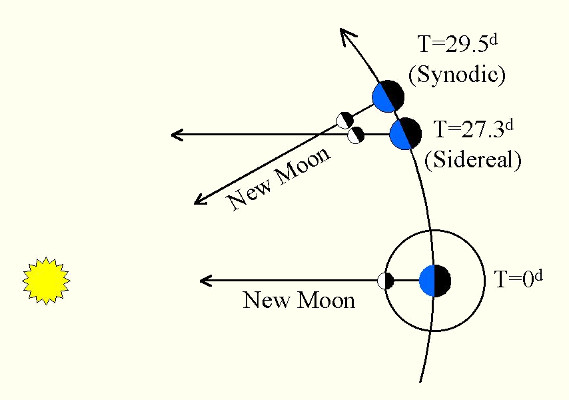
by John P. Pratt
1 Nov 2018, 1 Wind (SR), β Leo (US)
©2018 by John P. Pratt. All rights Reserved.
| 1. Proposed Restored List |
| 2. Comparison to Others |
| 3. Linked to Sacred Round |
| 4. Conclusion |
| Notes |
The ancient Babylonians as well as Arabs each had a list of 28 stars that represented milestones in the moon's monthly 27.3 day path through the stars. Those milestone places are called lunar mansions or lunar stations, with the former name more popular but the latter more descriptive because each is a single star. This article presents a modern list with stars that are roughly equally spaced around the moon's orbit in the zodiac constellations. That list is then compared to the Babylonian and Arab lists, showing that they agree in the areas of brighter stars.
 |
Modern astronomers do not take the list of lunar mansions seriously. In all of the astronomy classes I either took or taught they were not even mentioned. It is generally assumed they were used only for astrology, but it is my understanding that even astrologers rarely use them.
The ancients took them very seriously and the Babylonians and Arabs both had lists of exactly 28. Looking at those lists shows that the number 28 was important because their lists do not always have equally spaced stars, so it appears that extras have been crammed in to achieve a total of 28.
Given all of that confusion and neglect, is it really important to attempt to restore a "correct" list? What would it be used for?
The apparent use of 28 lunar stations is to be a set of holy days on the Star Calendar[1] determined solely by star positions rather than merely set days of the year. It was noticed that many important sacred events occurred on star days that had been on the Babylonian and Arab lists. Thus, an attempt has been made to restore a correct list.
The proposed list of stars is taken from the 364 stars included in the Star Calendar because their purpose is to define a set of holy days on that calendar.
The Star Calendar year has 364 days, which is exactly 28 sets of 13 days[2] so that is a perfect match with the desire for equally spaced lunar stations. Starting in Virgo, the first three stars are already 13 days apart from each other, so that looks like a natural place to align with. And sure enough, both the Babylonians and Arabs included those stars on their lists, so those were my anchor points.
Another consideration used in choosing the 28 lunar station stars was something that John the Revelator reported when he had his vision of the heavens. He said that besides the four beasts which surround the throne of God, there was also a circle of 24 seats for 24 elders (Rev. 4:4,7). Noting that 24 plus 4 is 28 really makes it sound like the 28 lunar stations might be the four cornerstone stars[3] along with 24 others chosen from the zodiac constellations, which are the path of the moon. The four corner constellations are a lion (Leo), a bull (Taurus), a man (Aquarius) and a serpent (scorpion), which is the evil counterpart of the flying eagle, just as John described the four beasts. The Book of Enoch makes it clear that the stars in the Star Calendar all represent faithful servants of God, so it seems acceptable to equate the 24 elders with 24 other stars of the lunar mansions.
Three of those four corner stars are very near the ecliptic and are already on the lists of both the Babylonians and Arabs, but the fourth is Fomalhaut which is rather far from that desired location. After much pondering, it was decided to use Fomalhaut to fill that slot because it follows the pattern of including all four cornerstone (royal) stars. Figure 2 shows a map of all 28 proposed stars. The map is a top view of the celestial sphere projected down into the ecliptic plane, with the ecliptic being the circle going through the twelve zodiac constellations.
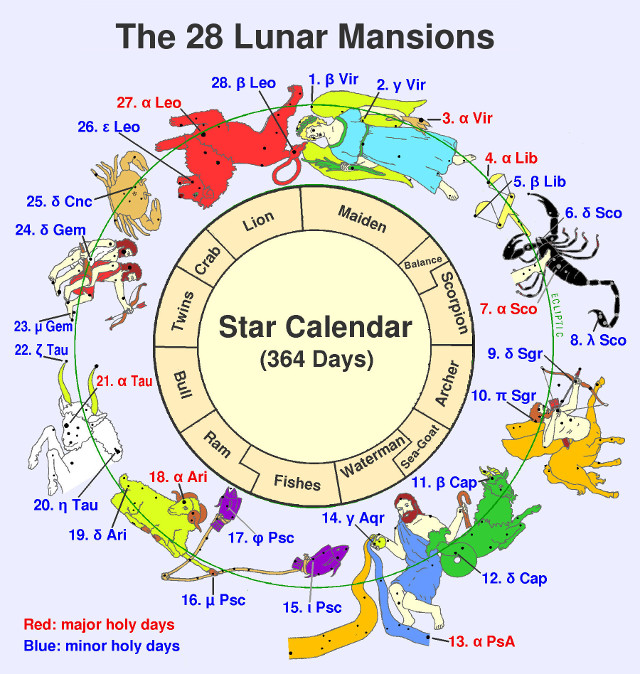 |
It can be seen that the proposed stations do not form an equally spaced set of stars. The first three in the Maiden (Virgo) are equally spaced at 13° apart as desired. The rules for choosing the other stars were that all must be in the zodiac constellations and at least be near to the ideal equally spaced stations from those in the Maiden. Also there must be at least one station in each constellation, including separate parts of constellations, such as in each of the two fishes in the Fishes (Pisces), the Water (stream of 7 stars flowing out of the jar of the Waterman, Aquarius) as well as one of the seven stars in Waterman, the Bow in the hand of the Archer (Sagittarius), and the Seed in the hand of the Maiden.
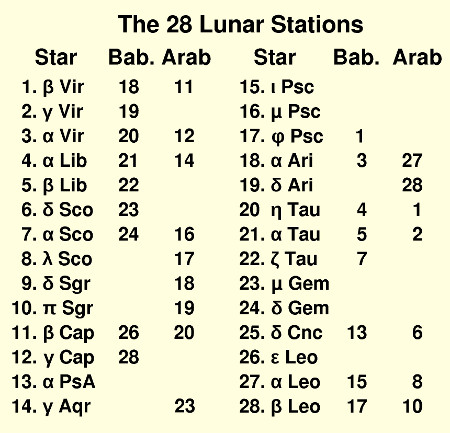 |
After this article was already begun something was noticed that was worthy of investigation. The choice had just been made that the eighth lunar station was the Stinger in the Scorpion, even though it is far from the ecliptic, rather than θ Ophiuchi, the star in the Serpent Bearer (Ophiuchus) in the foot which had been stung. That latter star is near the ecliptic and was used by the Babylonians to mark that lunar mansion, whereas the Arabs used the Stinger. Either star would have represented death. As it was pondered why death would be one of the stars, and indeed why the patriarch Enos (whose name means "mortal") and whose life represented mortality (he was born and died on 1 Skull, SR), would need to have an entire life depict death. Then suddenly something in Figure 2 really jumped out at me: not only is Death also one of the 20 figures on the 20-day veintena of the Sacred Round, the first figure in the veintena represents conception and the spark of light in the seed that begins life. If Spica, the Seed of Woman, the third lunar station is lined up with Light on the veintena, then the eighth station Stinger would align with Skull!
Immediately research was begun to see if all twenty of the veintena figures would match 20 of the 28 lunar mansions. Figure 3 shows the results. The alignment is far beyond chance because the order of all twenty of the stars which match the veintena are in the same order!
To attempt to align the stars and signs, there is a question of whether the 20 day names of the veintena include the 4 beasts or not. The answer seems to be clearly yes for two reasons. First, there is no extra lunar station between the Seed of Woman and the Stinger, which clearly match Light and the Skull, so Antares must be included. Second, the veintena day Water must match up with Fomalhaut, the End of the stream of Water! Thus, to fulfill that pattern, all four of the cornerstone stars are included in the veintena days.
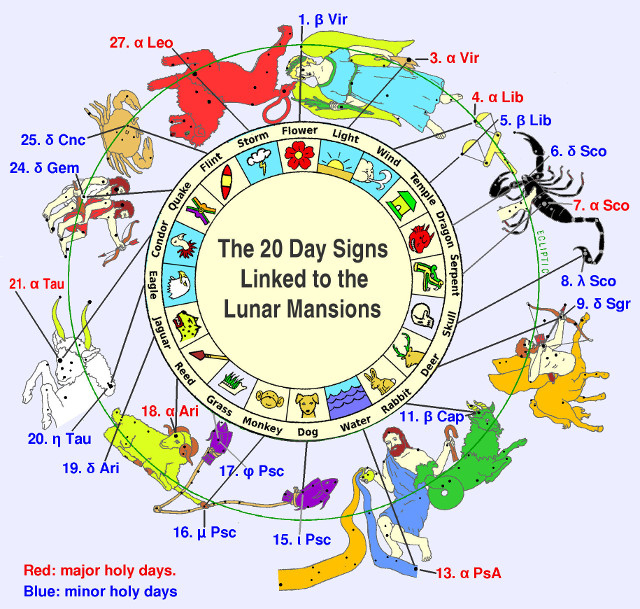 |
That leaves 16 other lunar stations to correspond to the remaining 16 veintena days, resulting in 8 lunar stations not being included. They could very well correspond to 8 other Hebrew Holy days because there are at least 28 of them. Moreover, they should be in the same order as the holy days fall in the year. Those questions are left for a future investigation.
The correlation of the 20 day signs of the veintena (the cycle of glyphs in the Sacred Round) to the lunar mansions is so impressive as to merit discussion. That is because all 20 of the veintena glyphs clearly align with 20 of the 28 lunar mansions in the same order! That did not happen by chance.
 The first day sign Light represents the spark of life within a seed and symbolizes either conception or the beginning of a project. It ties to the Hebrew Feast of Trumpets which heralds a coming event which occurs on the first day of Autumn.[5] Thus, it is perfect for it to link to the star named the "Seed of Woman" (Spica, Alpha Vir)! That was the star day of the Fall of Adam and of the day when the priests began their weekly courses in the temple of Solomon. Both represented the beginning of a new epoch.
The first day sign Light represents the spark of life within a seed and symbolizes either conception or the beginning of a project. It ties to the Hebrew Feast of Trumpets which heralds a coming event which occurs on the first day of Autumn.[5] Thus, it is perfect for it to link to the star named the "Seed of Woman" (Spica, Alpha Vir)! That was the star day of the Fall of Adam and of the day when the priests began their weekly courses in the temple of Solomon. Both represented the beginning of a new epoch.
 The second sign Wind represents when the spirit enlivens the fetus and ties to the spiritual Hebrew Day of Atonement. It links to the star "Redeemed" (Alpha Lib), which is tied to the Atonement. Some sacred events which have occurred on Redeemed which tie to the Spirit and Atonement were the ordinations of both Enoch and his father Jared, the day Moses raised the brazen serpent, the birth of the Virgin Mary, and both the baptism and transfiguration of Jesus.
The second sign Wind represents when the spirit enlivens the fetus and ties to the spiritual Hebrew Day of Atonement. It links to the star "Redeemed" (Alpha Lib), which is tied to the Atonement. Some sacred events which have occurred on Redeemed which tie to the Spirit and Atonement were the ordinations of both Enoch and his father Jared, the day Moses raised the brazen serpent, the birth of the Virgin Mary, and both the baptism and transfiguration of Jesus.
 The third sign Temple represents birth, when the developing life receives the temple of its body. The star "Lacking" is the upper tray (Beta Lib) of the Balance which represents man being weighed and found wanting (Dan. 5:27), hence needing redemption. On the Hebrew Calendar it corresponds to the Feast of Tabernacles, representing birth when one begins to live in a new tabernacle. This star represents fallen man and also a birth or beginning. Some events which occurred on this day were Eve offering the forbidden fruit to Adam, the beginning of the Deluge, the day King Josiah read the law of Moses to his people, and the coronation of King Jeconiah, who was later taken captive to Babylon. Thus, this sign is a good match for the Birth day sign.
The third sign Temple represents birth, when the developing life receives the temple of its body. The star "Lacking" is the upper tray (Beta Lib) of the Balance which represents man being weighed and found wanting (Dan. 5:27), hence needing redemption. On the Hebrew Calendar it corresponds to the Feast of Tabernacles, representing birth when one begins to live in a new tabernacle. This star represents fallen man and also a birth or beginning. Some events which occurred on this day were Eve offering the forbidden fruit to Adam, the beginning of the Deluge, the day King Josiah read the law of Moses to his people, and the coronation of King Jeconiah, who was later taken captive to Babylon. Thus, this sign is a good match for the Birth day sign.
 The fourth sign Dragon represents evil and links to the head of the Scorpion to the star named "Justice" (Delta Sco). It represents when temptation or evil enters a child's life, when the "natural man" is born, and when one becomes accountable at age 8. On the Hebrew Calendar it corresponds to when the Great Deluge began. The more general meaning is justice, when there is an evil consequence for sin. Some events on that star day were when Peleg was born, when his father Eber died, and when Judah died.
The fourth sign Dragon represents evil and links to the head of the Scorpion to the star named "Justice" (Delta Sco). It represents when temptation or evil enters a child's life, when the "natural man" is born, and when one becomes accountable at age 8. On the Hebrew Calendar it corresponds to when the Great Deluge began. The more general meaning is justice, when there is an evil consequence for sin. Some events on that star day were when Peleg was born, when his father Eber died, and when Judah died.
 The fifth sign Serpent symbolizes rebirth and links to the star Heart of Wisdom (Antares, Alpha Sco) at the heart of the Scorpion. That may not seem like a perfect match, but wisdom and rebirth are not unrelated. On the Hebrew Calendar it corresponds to the Feast of Dedication when the Temple was rededicated, similar to being reborn. One historical event which happened on that star day was the founding of Enoch's city of Zion.
The fifth sign Serpent symbolizes rebirth and links to the star Heart of Wisdom (Antares, Alpha Sco) at the heart of the Scorpion. That may not seem like a perfect match, but wisdom and rebirth are not unrelated. On the Hebrew Calendar it corresponds to the Feast of Dedication when the Temple was rededicated, similar to being reborn. One historical event which happened on that star day was the founding of Enoch's city of Zion.
 The sixth sign Skull ties directly to the Stinger on the Scorpion (Lambda Sco), so that is a perfect match with both representing death! It corresponds to the beginning of Winter on the Hebrew Calendar. One key event which occurred on that star day was the death of Adam's grandson Enos. As mentioned above, all of his vital dates relate to death, with him having been born and died on 1 Skull. Thus, his death is an example of an event which occurred on both 1 Skull and the Stinger.
The sixth sign Skull ties directly to the Stinger on the Scorpion (Lambda Sco), so that is a perfect match with both representing death! It corresponds to the beginning of Winter on the Hebrew Calendar. One key event which occurred on that star day was the death of Adam's grandson Enos. As mentioned above, all of his vital dates relate to death, with him having been born and died on 1 Skull. Thus, his death is an example of an event which occurred on both 1 Skull and the Stinger.
 The seventh sign Deer symbolizes being fleet of foot, swiftly moving in the spirit world after death. It ties to the arrow of the Archer (Delta Sco), which is swift indeed. It ties to the Winter Fast on the Hebrew Calendar.
The seventh sign Deer symbolizes being fleet of foot, swiftly moving in the spirit world after death. It ties to the arrow of the Archer (Delta Sco), which is swift indeed. It ties to the Winter Fast on the Hebrew Calendar.
 The eighth sign Rabbit represents materialism which needs to be sacrificed. The sacrificial Goat is a good match for the same concept. It links to the day 1 Shebat on the Hebrew Calendar, a day of sacrifice by the priests. It links to the lunar mansion star Beta Cap. The official name of that star is Arabic for "Sacrifice."
The eighth sign Rabbit represents materialism which needs to be sacrificed. The sacrificial Goat is a good match for the same concept. It links to the day 1 Shebat on the Hebrew Calendar, a day of sacrifice by the priests. It links to the lunar mansion star Beta Cap. The official name of that star is Arabic for "Sacrifice."
 The ninth sign Water is a perfect match for the Water of blessings being poured out by the Waterman. Its meanings include baptism which comes after the step of sacrificing materialism. For most people baptism comes posthumously after suffering some time in the spirit world. It ties to 14 Shebat, the birthday of Moses, named for being taken out of the water. The lunar mansion linked to it is Blessings (Fomalhaut, Alpha PsA), the last star in the stream of the Water. That star represented Noah, and one event on that star day was his death.
The ninth sign Water is a perfect match for the Water of blessings being poured out by the Waterman. Its meanings include baptism which comes after the step of sacrificing materialism. For most people baptism comes posthumously after suffering some time in the spirit world. It ties to 14 Shebat, the birthday of Moses, named for being taken out of the water. The lunar mansion linked to it is Blessings (Fomalhaut, Alpha PsA), the last star in the stream of the Water. That star represented Noah, and one event on that star day was his death.
 The tenth sign Dog represents anguish and is the counterpart of the Egyptian jackal Anubis who is the guide to the underworld after death. It is at the lowest point on the circle. On the Hebrew Calendar it corresponds to the Feast of Esther, when the Jews were expecting to be executed. It links to the star in the back of the Western Fish named "Burdened Back" (Iota Psc).
The tenth sign Dog represents anguish and is the counterpart of the Egyptian jackal Anubis who is the guide to the underworld after death. It is at the lowest point on the circle. On the Hebrew Calendar it corresponds to the Feast of Esther, when the Jews were expecting to be executed. It links to the star in the back of the Western Fish named "Burdened Back" (Iota Psc).
 The eleventh sign Monkey represents the first rung on the ladder beginning the ascent to heaven after having hit rock bottom. The Hebrew day corresponding to it is New Year's Day on 1 Nisan, beginning the spring. The name of the star is "Fish Net" (Mu Psc) which is cast out by the Ram to catch the fishes in Pisces. That star is actually in the forefoot of the Ram. An example sacred day is that it was the day of the beginning of the public ministry (first sermon) of the restored Church of Christ on Sun 11 Apr 1830. That could indeed be likened to first casting out the net, becoming fishers of men. Thus, the first step upward from the spirit prison would be to accept the gospel of Jesus Christ which is taught there (1 Peter 3:18-19, D&C 138:32-34).
The eleventh sign Monkey represents the first rung on the ladder beginning the ascent to heaven after having hit rock bottom. The Hebrew day corresponding to it is New Year's Day on 1 Nisan, beginning the spring. The name of the star is "Fish Net" (Mu Psc) which is cast out by the Ram to catch the fishes in Pisces. That star is actually in the forefoot of the Ram. An example sacred day is that it was the day of the beginning of the public ministry (first sermon) of the restored Church of Christ on Sun 11 Apr 1830. That could indeed be likened to first casting out the net, becoming fishers of men. Thus, the first step upward from the spirit prison would be to accept the gospel of Jesus Christ which is taught there (1 Peter 3:18-19, D&C 138:32-34).
 The twelfth sign Grass ties to the holy day Consecration on 10 Nisan on the Hebrew Calendar, when the Passover lamb is chosen and set apart from the flock. The name of the star (Phi Psc) is Eklektos, which is Greek for "Chosen" and was the star day on which Jacob died and also on which the Jewish temple was rededicated.
The twelfth sign Grass ties to the holy day Consecration on 10 Nisan on the Hebrew Calendar, when the Passover lamb is chosen and set apart from the flock. The name of the star (Phi Psc) is Eklektos, which is Greek for "Chosen" and was the star day on which Jacob died and also on which the Jewish temple was rededicated.
 The thirteenth sign Reed represents resurrection. It corresponds to Easter Sunday on the Hebrew Calendar, which occurs on the Sunday after Passover. The name of the star is "Risen Ram" (Hamal, Alpha Ari) in the constellation of the Ram. The resurrection of Christ occurred on this star day.
The thirteenth sign Reed represents resurrection. It corresponds to Easter Sunday on the Hebrew Calendar, which occurs on the Sunday after Passover. The name of the star is "Risen Ram" (Hamal, Alpha Ari) in the constellation of the Ram. The resurrection of Christ occurred on this star day.
 The fourteenth sign is Jaguar, which represents sanctification and possibly also the Aaronic Priesthood. It corresponds to the holy day 1 Sivan on the Hebrew Calendar, when Moses told his followers to begin their sanctification process to be ready to receive the law of God. Moses began each 40-day ascent up the mountain on a Jaguar day. The English name of the star is "Holy" (Del Ari), so that is a match.
The fourteenth sign is Jaguar, which represents sanctification and possibly also the Aaronic Priesthood. It corresponds to the holy day 1 Sivan on the Hebrew Calendar, when Moses told his followers to begin their sanctification process to be ready to receive the law of God. Moses began each 40-day ascent up the mountain on a Jaguar day. The English name of the star is "Holy" (Del Ari), so that is a match.

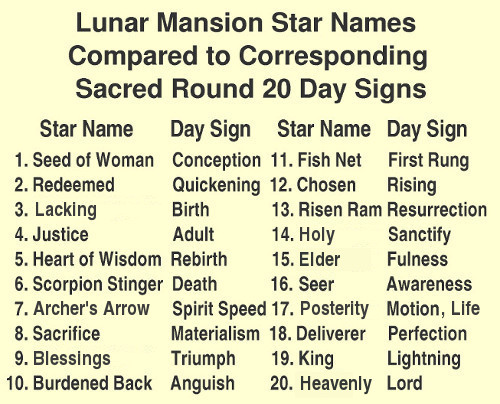 |
 The sixteenth sign is Condor, which flies higher than an Eagle and may be the Thunderbird, representing Patriarchal Priesthood. The Condor flies higher than the Eagle and overcomes death by eating it for lunch. The corresponding Hebrew holy day is the first day of Summer. The star is "The Seer" (Aldebaran, Alpha Tau) at the eye of the Bull, also representing being able to see visions. That star day was the birthday of the great seer Joseph of Egypt.
The sixteenth sign is Condor, which flies higher than an Eagle and may be the Thunderbird, representing Patriarchal Priesthood. The Condor flies higher than the Eagle and overcomes death by eating it for lunch. The corresponding Hebrew holy day is the first day of Summer. The star is "The Seer" (Aldebaran, Alpha Tau) at the eye of the Bull, also representing being able to see visions. That star day was the birthday of the great seer Joseph of Egypt.
 The seventeenth sign is Quake (or Motion), which represents shaking off the ashes after being purified by fire according to the Mayan priests. The corresponding Hebrew holy day is Raven day, when the Raven was released by Noah. In my studies it ties to Life, partly because moving things are associated with life. The star is the "Posterity" (Delta Gem), in a testicle of one of the Twins, so that is a perfect match for representing life and offspring.
The seventeenth sign is Quake (or Motion), which represents shaking off the ashes after being purified by fire according to the Mayan priests. The corresponding Hebrew holy day is Raven day, when the Raven was released by Noah. In my studies it ties to Life, partly because moving things are associated with life. The star is the "Posterity" (Delta Gem), in a testicle of one of the Twins, so that is a perfect match for representing life and offspring.
 The eighteenth sign is Flint, which is the flint knife used in priestly sacrifice. It corresponds to 1 Ab on the Hebrew Calendar, a day associated with priests. The star is named "Deliverer" (Delta Cnc) and is in the constellation of the Crab (Cancer) and, though dim, it is almost exactly on the ecliptic. When Jesus acted as a Deliverer and brought spirits out of prison even as a Crab can bring things from the sea to the land, it required a huge sacrifice on His part.
The eighteenth sign is Flint, which is the flint knife used in priestly sacrifice. It corresponds to 1 Ab on the Hebrew Calendar, a day associated with priests. The star is named "Deliverer" (Delta Cnc) and is in the constellation of the Crab (Cancer) and, though dim, it is almost exactly on the ecliptic. When Jesus acted as a Deliverer and brought spirits out of prison even as a Crab can bring things from the sea to the land, it required a huge sacrifice on His part.
 The nineteenth sign is Storm (a lightning storm), representing a countenance of lightning, one of the last steps to become like God. The Hebrew day is the Burning Fast, commemorating the burning of both temples and burning with the fire from heaven. The star day is the "King" (Regulus, Alpha Leo), which ties to being a king as well as a priest on the way to godhood. When the Savior returns as King of Kings, the wicked will be destroyed by fire, so that is a match.
The nineteenth sign is Storm (a lightning storm), representing a countenance of lightning, one of the last steps to become like God. The Hebrew day is the Burning Fast, commemorating the burning of both temples and burning with the fire from heaven. The star day is the "King" (Regulus, Alpha Leo), which ties to being a king as well as a priest on the way to godhood. When the Savior returns as King of Kings, the wicked will be destroyed by fire, so that is a match.
 The twentieth and last sign is Flower with the meaning "Lord". It is at the highest point of the circle and, like the Hindu lotus flower, represents becoming like unto God. The Hebrew day is 1 Elul. The star is named "Heavenly" (Zavijava, Beta Vir) because it is in the wing of the heavenly Maiden.
The twentieth and last sign is Flower with the meaning "Lord". It is at the highest point of the circle and, like the Hindu lotus flower, represents becoming like unto God. The Hebrew day is 1 Elul. The star is named "Heavenly" (Zavijava, Beta Vir) because it is in the wing of the heavenly Maiden.
Thus we see that most of the twenty day signs of the veintena have a clear correspondence with 20 of the 28 lunar mansions and in the same order (see Table 2 for name comparisons). This clearly testifies of design and points the way to many layers of new meanings.
A restored list of the ancient 28 lunar mansions (stations) is proposed and then compared to the Babylonian and Arab lists. Most of the stars on the new list are on one of those traditional lists. The main purpose of the lunar mansions seems to be that they are at least minor holy days on the Star Calendar.
An unexpected discovery was also reported, namely, that there is a clear correspondence of the twenty day signs of the Sacred Round to 20 of the 28 lunar mansions. It is far beyond being a chance coincidence because several of the signs are nearly identical, such as Water and Water, but also because they are in the same order. More research is needed to explore the depth and implications of this relationship, but it clearly is yet another witness of the hand of the Creator.